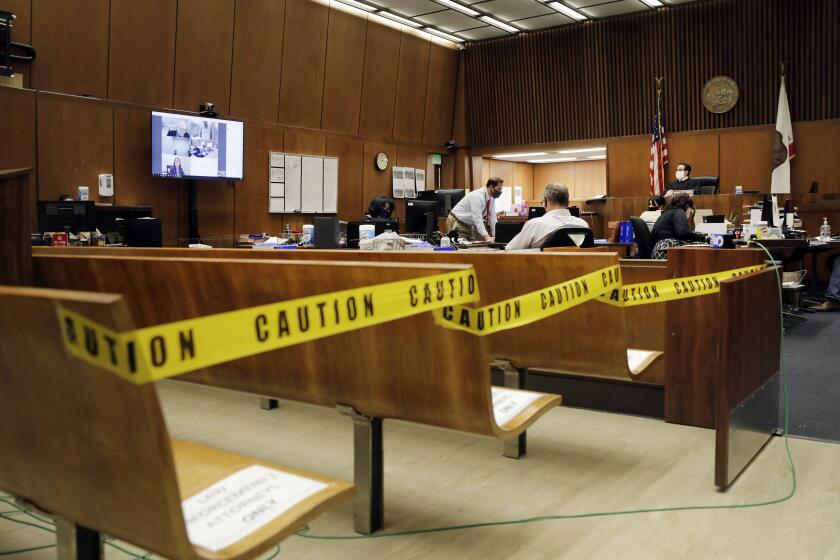Mentally retarded adults at a day center in Downey strive for the smallest bits of knowledge.
For Eddie, it is not easy picking the correct picture from among those on the bulletin board.
“If you have to wash your hands where are you going to go?” asks teacher Linda Ripley, pointing to a sandwich, a toilet, a sink, a glass of milk, some candy, a bus, a book, a bottle of soda, a chair and some faces.
Eddie, his frail body hunched and a smile seeping from his lips, points to the wash basin--no large feat for a 4-year-old but a good piece of work for a 28-year-old man who is severely mentally retarded and has cerebral palsy.
Taken with himself, he laughs and slowly returns to his seat.
Eddie is one of 50 profoundly or severely retarded adults who learn the simplest of tasks at the day center in Downey run by the Assn. for Retarded Citizens-Southeast, a nonprofit organization that has served this part of Los Angeles County since 1956.
The ARC-Southeast, one of seven ARC facilities in the county, celebrated the 15th anniversary of its Day Training Activity Center this month.
The day center is a portal between the inside of a mental institution and the outside world. It is a school where the most seriously mentally retarded reach for the smallest bits of knowledge that can be secured by their flawed intelligence. Profoundly mentally retarded is the most limiting of four categories, which include severe, moderate and mild mental retardation.
“Our primary purpose is to keep them out of a state hospital,” says Jo Ann Blik, coordinator of adult special classes at ARC-Southeast, as she takes a visitor through the facility. “Many of them have come from a state hospital.”
The hallways smell of disinfectant. As the visitor enters one of the carpeted classrooms with its yellow- and rust-colored walls, many of the clients are intrigued. They mutter a greeting and want a handshake.
Like Eddie, Steven, 27, is severely mentally retarded and suffers from cerebral palsy. Naomi, 47, was normal during her first eight months of life, then she contracted various diseases, including spinal meningitis, which left her profoundly mentally retarded and partially paralyzed. Twins Bernard and Renard, 31, have Down’s Syndrome.
According to ARC statistics, seven million people in the country are mentally retarded, and 100,000 retarded babies are added each year. In Los Angeles County, the state Department of Developmental Services says it has records of 21,000 mentally retarded people.
The day center clients, who are referred by several Regional Centers for the Developmentally Disabled, are separated for classroom purposes into higher-functioning and lower-functioning groups. Most are unable to talk.
Once in the classrooms, some of the lower-functioning clients work on simple word identification. They are taught simple communication skills, including some signing, so they can communicate when they need to eat, drink or go to the bathroom. Others try to place blocks and pegs in square and round holes.
Ripley, one of two teachers at the center, does not like to attach an age level to any of the activities of the lower-functioning group, but when pressed she says, “It will range from early months--six months--to 2 1/2 years.” Six aides assist in the activities center.
One of the primary objectives is to increase the clients’ attention span and get them to better follow directions.
When clients succeed, they are rewarded with a word of encouragement, a smile of approval, and sometimes with food.
“At that level, for many of our clients, food is the biggest thing in their life,” Ripley points out.
They also are taught skills such as putting on and taking off a jacket, washing their hands, and how to use a bathroom and seat belt. The center does not toilet train. Some clients are already trained, others are habit trained--they are taken to the bathroom every 90 minutes to two hours.
Lower-functioning clients are painting in another room. They wear old dress shirts turned backward. The theme is St. Patrick’s Day.
An intent Bernard puts down bold streaks of yellow and blue around a three-leaf clover. Jeff, 32, who is severely retarded, has a little green paint around his mouth, evidence of a taste test.
Later, tambourines, small cymbals and other percussion instruments are brought out and the clients play and bob, moving to a lively recording.
The observable world of the profoundly and severely retarded is mostly a quiet one, broken by a grunt, a laugh or a shriek.
“I think they see, think and feel more than people give them credit for, especially feel,” Ripley says.
Clients in the higher-functioning group are taught skills such as printing their names and sorting multicolored plastic washers. They work for the day when they can graduate to ARC-Southeast’s Work Training Center, where 250 mostly moderately retarded clients perform simple packaging and assembling tasks. The work is subcontracted from area businesses.
Proceeds from workshop contracts and an ARC-operated thrift store bolster state funding and donations to ARC-Southeast, spokeswoman Liggett McLaws says. Downey Adult School provides the teachers.
The day center, which is open from 8:30 a.m. to 3:30 p.m. Monday through Friday, runs on $182,000 of ARC-Southeast’s $2.15-million annual budget, according to Howard Buswell, executive director.
Some clients make the transition from the day activities center to the workshop program, but most do not. In the 15-year history of the center, just 18 clients have graduated to the Work Training Center, McLaws says.
John, 37, whose moderate retardation is complicated by an organic brain disorder and a personality disorder, was once in the workshop program. But he was transfered to the day activities center because he is easily distracted and requires too much supervision, Blik says. He sorts black, red and white washers.
Asked what he wanted to do if he made it back into the workshop, John says, “Make pumps,” and then resumes his sorting. John’s task in the workshop was to help assemble water bed pumps.
Most clients spend year after year in the program, and what the instructors hope for is that they will realize their potential, even if it is limited.
“Realistically, there are probably some who will not make it out of my class,” Ripley says. “What we shoot for is that they become as independent as possible in their setting, that they can get a glass and get a drink of water or even indicate they’re thirsty.”
More to Read
Start your day right
Sign up for Essential California for news, features and recommendations from the L.A. Times and beyond in your inbox six days a week.
You may occasionally receive promotional content from the Los Angeles Times.






